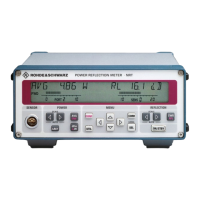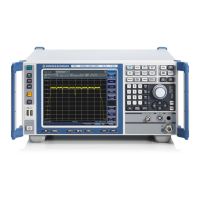Instrument Functions
NRP2
158User Manual 1173.9140.02 ─ 07
of time, during which the R&S NRP2 can still regularly update the output voltage,
depends on the number of sensors connected and their measurement modes. With
one sensor connected, operated in the ContAv mode, it is about 1 ms.
Switching on the averaging filter does not affect the refresh rate, but the speed at
which the output voltage changes can be expected to slow down as a result of the filter
effect.
For applications having high requirements on the dynamic behavior of the analog out-
puts, for example leveling loops, it is advisable to freeze the screen of the R&S NRP2
to avoid interruptions caused by writing to the display memory (chapter 4.7.5, "Miscel-
laneous", on page 160).
4.7.3
Sensor Check Source
The Sensor Check Source, option R&S NRP-B1/-B7, supplies an accurate 1 mW test
signal at 50 MHz. Option R&S NRP-B7 comes with an additional pulse mode of the
test signal with a modulation frequency of 10 kHz. It can arbitrarily be switched on and
off or be used in course of automatic test measurements, see chapter 4.7.6, "Test
measurements", on page 161.
►
The signal is activated in the "System" menu.
Fig. 4-89: Power Ref Selection for R&S NRP-B1 (left) and R&S NRP-B7 (right)
Power Ref
Switches on/off the sensor check source.
Remote command:
OUTPut:ROSCillator[:
STATe] on page 258
4.7.4 System information
This section describes how you retrieve information on the instrument like part number,
serial number, firmware version, etc. and installed options, as well as on connected
power sensors.
System settings
北京海洋兴业科技股份有限公司(证券代码:839145)

